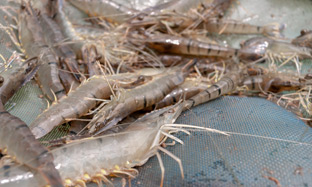 (1) (1)-min.jpg)
What are optimum water and soil parameters for shrimp and fish culture?
Shrimp culture in ponds has been expanded to be a bio-food industry proved to yield foreign exchange and provide job opportunities besides animal protein source.
The existence of a wide market support, stable price, technology support in the production process, commercial as input, the potential land availability, and the Government’s policy support has led to shrimp commodity to continually grow being the excellent fishery and continue to be developed as the excellent commodity to increase foreign exchange.
Nevertheless, the sustainability pond aquaculture in highly depends on the dynamic aspects of coastal environment quality as a result of any interaction among users in the coastal area besides pond aquaculture activity itself.
The collection of biophysical data and waters quality was consisted of pond soil quality, water quality, oceanography (tide, current speed and depth), shrimp farm sediment quality, and coastal waters base land substrate data. Pond soil quality data was collected from 10 stations in several pond compartments. Meanwhile, for the coastal waters water quality data was collected from 6 stations consisted of 2 stations of river, 2 stations of pond and 2 stations of outlets. Moreover, shrimp farm sediment quality and coastal waters base substrate quality data were collected from 2 stations and 13 sampling points, respectively.
Primery and secondary data were used in this study. Primery data was collected through observation and direct interview in the research location whilst, secondary data was obtained through the searching of various refferences to the several Agencies of Goverment and non Goverment that are related to this study. Several water quality parameters as listed in Table 1 which were the important parameters in the shrimp aquaculture success.
The salinity measurement result showed that the salinity obtained in the river and coastal waters was still in the values recommended namely 17.95 ± 3.79o/oo and 30.90 ± 4.01o/oo, respectively. Boyd, Poernomo, Widigdo, Soewardi recommended that Salinity of 5-35o/oo are suitable for shrimp culture and the salinity of 15-25o/oo are salinity suggested for the optimum growth of shrimp.
Maintenance of an adequate level of DO in pond water is very important for shrimp survival and prolonged exposure to the stress of low concentration of oxygen can inhibit shrimp growth. DO concentration in this study was considered normal and acceptable for a shrimp pond. Over the observation period, mean dissolved oxygen concentrations found in the waters was 6.65 ± 1.08 mg/l. Meanwhile, dissolved oxygen concentrations in shrimp farm for 24 hours of the observation ranged from 5.89-6.02 mg/l with the highest dissolved oxygen (6.02 mg/l) at 12.00 and the lowest (5.89 mg/l) at 20.00. In addition, mean dissolved oxygen concentration in the river and coastal waters was 6.02 ± 0.86 and 5.88 ± 1.42 mg/l, respectively. These values are still suitable for shrimp culture as reported by Boyd, Poernomo , Widigdo, the tolerance dissolved oxygen for shrimp culture is ≥ 3 mg/l (3 -10 mg/l) and the optimum dissolved oxygen ranges from 4-7 mg/l. Cheng et al., [10] reported that DO values higher than 5 mg/l have often been recommended for intensive culture practices.
Total suspended solid (TSS) measurement result exhibited that TSS value in shrimp farm was 37.73 ± 12.44 mg/l whilst, TSS value in outlet of traditional shrimp farm was 55.20 ± 10.54 mg/l. Moreover, this value for coastal waters and river was 58.17 ± 22.18 mg/l and 60.13 ± 15.45 mg/l, respectively. These TSS content were still in the tolerance limit for shrimp pond culture according to the tolerance value reported by Widigdo, Environment Ministry for shrimp farm namely 25-80 mg/l.
Biochemical Oxygen Demand (BOD5) measurement obtained BOD5 value was 1.16 ± 0.53 mg/l whilst, the BOD5 value for coastal waters and river was 0.74 ± 0.27 mg/l and 1.32 ± 0.80 mg/l, respectively. These BOD5 values are still suitable for shrimp culture based on the BOD5 value recommended by Environment Ministry (2004) namely < 25 mg/l. According to the pollution level, coastal waters of Mangara Bombang District is in unpolluted waters category indicating that it is suitable for shrimp culture.
Ammonia (NH3-N) content observed in shrimp farm waters was 0.02614 ± 0.3355 mg/l. Meanwhile, ammoniac (NH3-N) content obtained in coastal waters and river was 0.2636 ± 0.3303 mg/l and 0.1101 ± 0.0812 mg/l, respectively. These ammonia contents found are still in the save limit for shrimp culture based on the ammonia (NH3-N) content suggested by Boyd, Poernomo, Widigdo, Environment Ministry namely <1.0 mg/l.
The study has provided the information about the water quality status of Mangara Bombang District and its suitability for pond shrimp farm. The field and laboratory observations on the water quality revealed that the study area have high potential for pond shrimp culture development based on values obtained which were in conformity with recommended values for shrimp culture.

